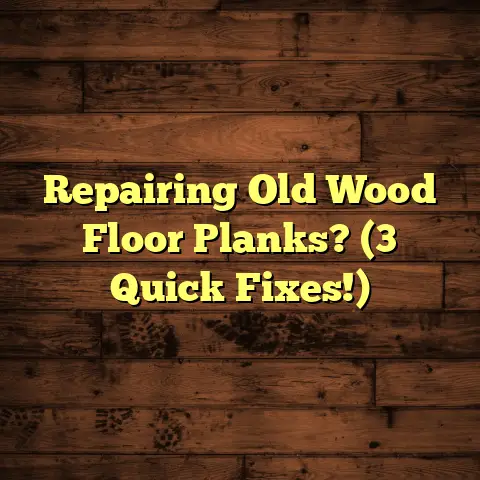Remove Wax From Laminate (4 Fixes, Quick!)
Laminate flooring is a fantastic choice for many reasons.
It’s affordable, durable, and looks amazing, mimicking everything from hardwood to stone.
It’s no wonder it’s a popular choice for homes and rentals alike.
But let’s be real, laminate isn’t invincible.
One issue I see pop up time and again is wax buildup.
While a fresh coat of wax might seem like a good idea for a temporary shine, it can quickly turn into a sticky, dull mess.
That’s why I’m here to share my tried-and-true methods for removing wax buildup quickly and effectively.
I’m going to walk you through four fixes that’ll have your laminate looking its best in no time.
So, let’s dive in!
Understanding the Problem
Okay, first things first, let’s break down what we’re dealing with.
What is Wax Buildup?
Wax buildup is exactly what it sounds like: an accumulation of wax on the surface of your laminate flooring.
This can happen over time as wax-containing products are used repeatedly, creating a layered residue.
Common Sources of Wax
Where does all this wax come from, you ask?
Here are some common culprits I’ve encountered:
-
Cleaning Products: Many cleaning products, especially those promising a “shine,” contain wax.
-
Furniture Polish: That furniture polish you’re using can easily transfer to the floor.
Candle Drips: A classic!
Those romantic candlelit dinners can lead to wax drippings that harden on your floor.
The Effects of Wax
So, why is wax buildup a problem?
Well, it’s not just about aesthetics.
Here’s what wax can do to your laminate:
-
Dullness: Instead of a beautiful shine, you get a cloudy, lackluster surface.
-
Slipperiness: Wax can create a slick surface, making your floors a safety hazard.
-
Damage to the Finish: Over time, wax can interact with the laminate’s protective layer, potentially causing damage.
Why Address it Promptly?
Addressing wax buildup quickly is key.
The longer you wait, the harder it becomes to remove, and the more likely it is to cause lasting damage.
Trust me, a little effort now can save you a lot of headaches (and money) down the road.
Preparation for Wax Removal
Before we jump into the fixes, let’s get prepared.
Tools and Materials
Here’s what you’ll need to tackle wax buildup like a pro:
-
Soft Cloths or Mop: Microfiber cloths are my go-to for gentle yet effective cleaning.
-
Warm Water: Essential for rinsing and diluting cleaning solutions.
-
Vinegar or Baking Soda: Our natural cleaning superheroes!
-
Commercial Wax Remover (Optional): If the natural methods don’t cut it, a commercial product might be necessary.
The Importance of Testing
This is crucial!
Before applying any cleaning solution to your entire floor, test it on a small, inconspicuous area.
I usually recommend testing in a closet or under a piece of furniture.
This ensures the solution won’t damage or discolor your laminate.
Preparing the Workspace
A little prep goes a long way. Here’s how to get your workspace ready:
-
Clear Furniture: Move any furniture out of the affected area to give yourself room to work.
-
Ventilation: Open windows or turn on a fan to ensure good ventilation.
Quick Fix #1 – Vinegar Solution
Vinegar is a fantastic natural cleaner, and it works wonders on wax buildup.
Creating the Vinegar Solution
Mix equal parts white vinegar and warm water in a bucket or spray bottle.
I usually go for a 1:1 ratio, but you can adjust it based on the severity of the wax buildup.
Step-by-Step Instructions
-
Dampen a Cloth: Dip a soft cloth or mop into the vinegar solution, making sure it’s damp but not soaking wet.
Wipe the Affected Areas: Gently wipe the waxy areas, allowing the solution to penetrate the wax.
Don’t scrub too hard, as this could damage the laminate.-
Rinse with Clean Water: After wiping with the vinegar solution, rinse the area with a clean, damp cloth to remove any residue.
-
Dry the Area: Use a clean, dry cloth to dry the floor thoroughly.
Effectiveness and Tips
Vinegar is effective because its acidity helps break down the wax.
Here are some tips for optimal results:
-
Warm Water: Warm water helps dissolve the wax more effectively than cold water.
-
Gentle Wiping: Avoid excessive scrubbing, which can damage the laminate’s finish.
-
Thorough Drying: Make sure to dry the floor completely to prevent water spots.
Potential Concerns
Some people worry about using vinegar on laminate, but it’s generally safe when diluted properly.
However, avoid using undiluted vinegar, as it can damage the flooring over time.
Quick Fix #2 – Baking Soda Paste
Baking soda is another excellent natural cleaner that can help remove wax.
Creating the Baking Soda Paste
Mix baking soda with a small amount of water to create a paste-like consistency.
You want it to be thick enough to stay in place when applied to the floor.
Applying the Paste
-
Apply to Waxy Spots: Apply the baking soda paste directly to the waxy spots on your laminate floor.
-
Gently Scrub: Use a soft cloth to gently scrub the paste into the wax.
-
Rinse Thoroughly: Rinse the area thoroughly with clean water to remove all traces of the baking soda paste.
-
Dry the Area: Use a clean, dry cloth to dry the floor completely.
Why Baking Soda is Safe
Baking soda is a mild abrasive, making it effective at removing wax without scratching the laminate.
Plus, it’s non-toxic and safe for your family and pets.
Additional Tips
-
Patience is Key: Give the paste a few minutes to sit on the wax before scrubbing.
-
Soft Cloth: Always use a soft cloth to avoid scratching the laminate.
-
Thorough Rinsing: Make sure to rinse away all the baking soda residue to prevent a dull film from forming.
Quick Fix #3 – Commercial Wax Remover
When natural methods aren’t enough, it’s time to bring in the big guns: commercial wax removers.
Overview of Commercial Wax Removers
There are many commercial wax removers available, but it’s crucial to choose one that’s specifically designed for laminate flooring.
Look for products that are non-abrasive and pH-neutral.
Selecting a Suitable Product
Read the product labels carefully and look for phrases like “safe for laminate” or “non-toxic.” I always recommend checking online reviews to see what other users have to say about the product’s effectiveness and safety.
Step-by-Step Process
-
Read the Instructions: This is non-negotiable! Follow the manufacturer’s instructions to the letter.
-
Apply the Product: Apply the wax remover to the affected area using a soft cloth.
-
Allow to Sit: Let the product sit for the amount of time specified in the instructions.
-
Wipe Away: Wipe away the wax remover with a clean, damp cloth.
-
Dry the Area: Use a clean, dry cloth to dry the floor thoroughly.
Pros and Cons
Pros:
-
Effective: Commercial wax removers are often more effective than homemade solutions for stubborn wax buildup.
-
Convenient: They’re readily available and easy to use.
Cons:
-
Cost: Commercial products can be more expensive than natural alternatives.
-
Chemicals: They often contain harsh chemicals that may be harmful to your health or the environment.
Quick Fix #4 – Rubbing Alcohol Method
Rubbing alcohol, also known as isopropyl alcohol, is another effective way to remove wax from laminate flooring.
Step-by-Step Process
Dampen a Cloth: Lightly dampen a clean, soft cloth with rubbing alcohol.
It’s important not to saturate the cloth; a little goes a long way.Gently Rub the Waxy Areas: Gently rub the waxy areas with the damp cloth.
The alcohol helps to dissolve the wax, making it easier to lift from the surface of the laminate.-
Clean with a Damp Cloth: After rubbing the waxy areas, use a separate clean, damp cloth to wipe away any remaining alcohol and dissolved wax residue.
Dry the Area: Finally, use a clean, dry cloth to dry the area thoroughly.
This helps prevent any potential water spots or damage to the laminate.
Advantages of Using Rubbing Alcohol
Quick-Drying Properties: Rubbing alcohol evaporates quickly, which means you won’t have to wait long for the treated area to dry.
This is especially useful in high-traffic areas where you want to minimize disruption.-
Effectiveness: Rubbing alcohol is a powerful solvent that can effectively dissolve wax and other stubborn residues, making it a reliable choice for wax removal.
Precautions
Ventilation: Ensure the area is well-ventilated when using rubbing alcohol.
Open windows or turn on a fan to avoid inhaling too many fumes.-
Test Area: As with any cleaning method, test the rubbing alcohol on a small, inconspicuous area of the laminate flooring first to ensure it doesn’t cause any discoloration or damage.
Conclusion
Maintaining laminate flooring is all about regular care and addressing issues promptly.
Wax buildup is a common problem, but with these four quick fixes, you can keep your floors looking their best.
Remember, prevention is key.
Avoid using wax-containing cleaning products and clean up spills immediately.
With a little effort, your laminate flooring will stay beautiful for years to come.
So, there you have it!
Four quick and effective ways to remove wax from your laminate floors.
Choose the method that works best for you and get ready to enjoy your sparkling clean floors.
Happy cleaning!





